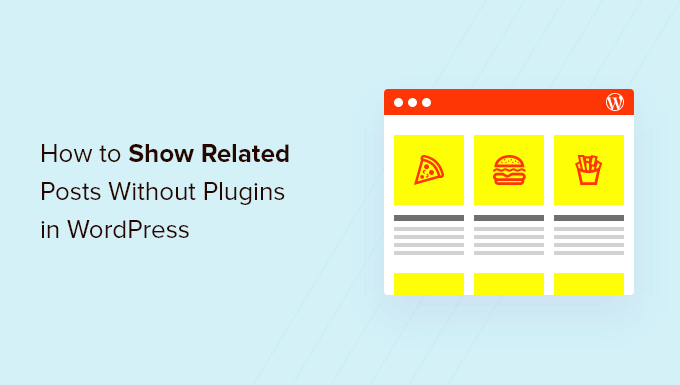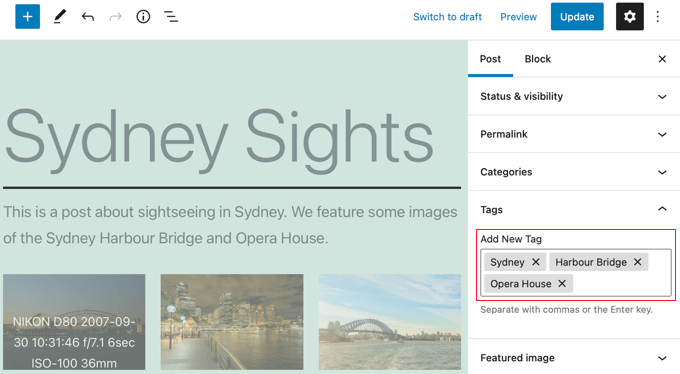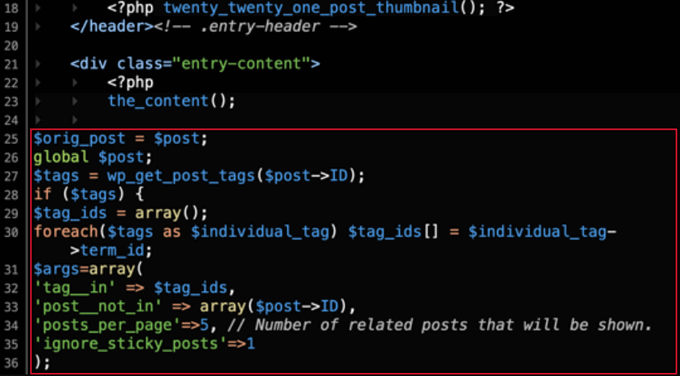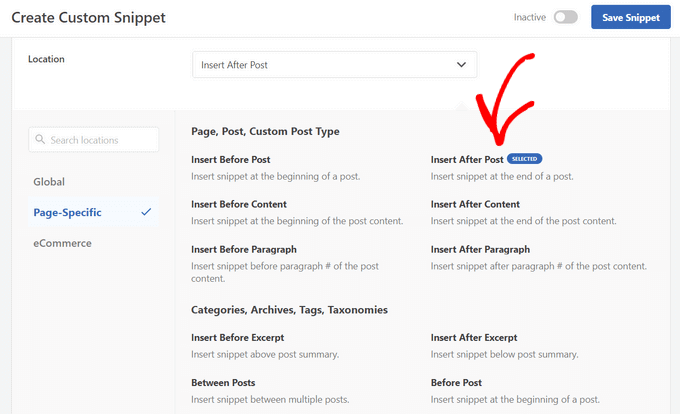Möchten Sie eine Liste verwandter Beiträge auf Ihrer WordPress-Website anzeigen und lieber Code als ein Plugin verwenden?
Bei WPBeginner betonen wir oft, wie wichtig es ist, Ihr Publikum zu fesseln und es dazu zu bringen, Ihre Inhalte zu erkunden. Eine effektive Strategie, die wir auf unzähligen erfolgreichen WordPress-Websites gesehen haben, ist die Anzeige von verwandten Beiträgen.
Wenn die Besucher Ihres Blogs einen Artikel, der sie interessiert, zu Ende gelesen haben, können Sie ihnen eine Liste mit verwandten Beiträgen anbieten, um sie bei der Stange zu halten und ihnen zu helfen, neue Inhalte zu lesen.
In diesem Artikel zeigen wir Ihnen, wie Sie mit WordPress verwandte Beiträge mit Code anzeigen können, ohne dass ein Plugin erforderlich ist.

Warum verwandte Beiträge in WordPress anzeigen?
Wenn Ihr WordPress-Blog zu wachsen beginnt, kann es für die Benutzer schwieriger werden, andere Beiträge zum selben Thema zu finden.
Die Anzeige einer Liste verwandter Inhalte am Ende jedes Blogbeitrags ist eine gute Möglichkeit, Ihre Besucher auf Ihrer Website zu halten und die Seitenaufrufe zu erhöhen. Es hilft auch, die Sichtbarkeit Ihrer wichtigsten Seiten zu verbessern, indem Ihre besten Inhalte dort angezeigt werden, wo die Besucher sie leicht finden können.
Wenn Sie mit Code nicht vertraut sind, ist es einfacher, eines der vielen WordPress-Plugins für verwandte Beiträge zu wählen, die verwandte Beiträge ohne Code anzeigen können.
Wenn Sie sich aber schon immer gefragt haben, ob Sie verwandte Beiträge auch ohne Plugins anzeigen können, stellen wir Ihnen zwei verschiedene Algorithmen vor, mit denen Sie verwandte Beiträge mit Vorschaubildern allein mit Hilfe des Codes erzeugen können:
Hinweis: Wenn Sie zu jedem verwandten Beitrag ein Thumbnail anzeigen möchten, müssen Sie diesen Beiträgen zunächst ein Bild hinzufügen.
Methode 1: Wie man verwandte Beiträge in WordPress nach Tags anzeigt
Eine effiziente Möglichkeit, verwandte Inhalte zu finden, besteht darin, nach anderen Beiträgen zu suchen, die dieselben Tags aufweisen. Tags werden oft verwendet, um sich auf die spezifischen Details in einem Beitrag zu konzentrieren.
Daher sollten Sie den Beiträgen, die Sie miteinander in Verbindung bringen möchten, einige gemeinsame Tags hinzufügen. Sie können sie in das Feld “Tags” im WordPress-Editor eingeben.

Nachdem Sie Schlagwörter zu Ihren Beiträgen hinzugefügt haben, müssen Sie als Nächstes das folgende Code-Snippet in das Template single.php Ihres Themes einfügen.
Wenn Sie Hilfe beim Hinzufügen von Code zu Ihrer Website benötigen, lesen Sie unsere Anleitung zum Einfügen von Snippets aus dem Internet in WordPress.
1 2 3 4 5 6 7 8 9 10 11 12 13 14 15 16 17 18 19 20 21 22 23 24 25 26 27 28 29 30 31 32 | $orig_post = $post;global $post;$tags = wp_get_post_tags($post->ID);if ($tags) {$tag_ids = array();foreach($tags as $individual_tag) $tag_ids[] = $individual_tag->term_id;$args=array('tag__in' => $tag_ids,'post__not_in' => array($post->ID),'posts_per_page'=>5, // Number of related posts that will be shown.'ignore_sticky_posts'=>1);$my_query = new wp_query( $args );if( $my_query->have_posts() ) { echo '<div id="relatedposts"><h3>Related Posts</h3><ul>'; while( $my_query->have_posts() ) {$my_query->the_post(); ?> <li><div class="relatedthumb"><a href="<?php the_permalink()?>" rel="bookmark" title="<?php the_title(); ?>"><!--?php the_post_thumbnail(); ?--></a></div><div class="relatedcontent"><h3><a href="<?php the_permalink()?>" rel="bookmark" title="<?php the_title(); ?>"><!--?php the_title(); ?--></a></h3><!--?php the_time('M j, Y') ?--></div></li><!--?php }echo '</ul--></ul></div>';}}$post = $orig_post;wp_reset_query(); |
Dieser Code sucht nach Tags, die mit einer Seite verbunden sind, und führt dann eine Datenbankabfrage aus, um Seiten mit ähnlichen Tags zu finden.
Wo sollten Sie den Code platzieren? Das hängt von Ihrem Theme ab, aber in den meisten Fällen sollten Sie den Code in die Vorlage single.php Ihres Themes nach dem Hauptbeitrag und direkt über dem Kommentarbereich einfügen können.
Wenn Sie das Twenty Twenty-One-Theme verwenden, wie wir es auf unserer Demoseite tun, dann ist ein guter Ort, um den Code in die Datei template-parts/content/content-single.php nach dem Header und direkt nach <?php the_content(); einzufügen.

Dadurch werden verwandte Inhalte automatisch in jedem WordPress-Beitrag angezeigt. Sie müssen das Styling und das Aussehen Ihrer verwandten Beiträge ändern, um sie an Ihr Theme anzupassen, indem Sie benutzerdefiniertes CSS hinzufügen.

Tipp: Anstatt die Dateien Ihres Themes zu bearbeiten, was Ihre Website zerstören könnte, empfehlen wir die Verwendung eines Code-Snippets-Plugins wie WPCode.
WPCode macht es sicher und einfach, benutzerdefinierten Code in WordPress hinzuzufügen. Außerdem bietet es “Einfügeoptionen”, mit denen Sie automatisch Snippets an bestimmten Stellen Ihrer WordPress-Website einfügen und ausführen können, z. B. nach einem Beitrag.

Weitere Details finden Sie in unserem Leitfaden zum Hinzufügen von benutzerdefiniertem Code in WordPress. Sie können auch unseren ausführlichen WPCode-Test lesen, um mehr über das Plugin zu erfahren.
Methode 2: Verwandte Beiträge in WordPress nach Kategorie anzeigen
Eine weitere Möglichkeit, verwandte Inhalte anzuzeigen, ist die Auflistung von Beiträgen, die sich in derselben Kategorie befinden. Der Vorteil dieser Methode ist, dass die Liste der verwandten Beiträge fast nie leer ist.
Wie bei Methode 1 müssen Sie einen Code-Snippet in die Vorlage single.php Ihres Themes oder in ein Code-Snippets-Plugin wie WPCode einfügen. Weitere Einzelheiten finden Sie unter Methode 1 und in unserer Anleitung zum Hinzufügen von benutzerdefiniertem Code in WordPress.
1 2 3 4 5 6 7 8 9 10 11 12 13 14 15 16 17 18 19 20 21 22 23 24 25 26 27 28 29 30 | $orig_post = $post;global $post;$categories = get_the_category($post->ID);if ($categories) {$category_ids = array();foreach($categories as $individual_category) $category_ids[] = $individual_category->term_id;$args=array('category__in' => $category_ids,'post__not_in' => array($post->ID),'posts_per_page'=> 2, // Number of related posts that will be shown.'ignore_sticky_posts'=>1);$my_query = new wp_query( $args );if( $my_query->have_posts() ) {echo '<div id="related_posts"><h3>Related Posts</h3><ul>';while( $my_query->have_posts() ) {$my_query->the_post();?> <li><div class="relatedthumb"><a href="<?php the_permalink()?>" rel="bookmark" title="<?php the_title(); ?>"><!--?php the_post_thumbnail(); ?--></a></div><div class="relatedcontent"><h3><a href="<?php the_permalink()?>" rel="bookmark" title="<?php the_title(); ?>"><!--?php the_title(); ?--></a></h3><!--?php the_time('M j, Y') ?--></div></li><!--?php }echo '</ul--></ul></div>';}}$post = $orig_post;wp_reset_query(); |
Jetzt sehen Sie eine Liste mit verwandten Inhalten am Ende jedes Beitrags.
Wenn Sie die Gestaltung und das Erscheinungsbild Ihrer verwandten Seiten ändern möchten, müssen Sie benutzerdefinierte CSS hinzufügen, die zu Ihrem Thema passen.
Expertenanleitungen zu verwandten Beiträgen in WordPress
Möchten Sie mehr über die Anzeige von verwandten Beiträgen in WordPress erfahren? Sehen Sie sich diese hilfreichen Tutorials zu verwandten Beiträgen an:
- Wie man verwandte Beiträge in WordPress anzeigt (Schritt für Schritt)
- Wie man verwandte Beiträge desselben Autors in WordPress anzeigt
- Hinzufügen von Inline Related Posts in WordPress Blog Beiträgen
- Wie man zufällige Beiträge in WordPress anzeigt
- Wie man verwandte Seiten in WordPress anzeigt
Wir hoffen, dass dieses Tutorial Ihnen geholfen hat zu lernen, wie man verwandte Beiträge mit Miniaturansichten in WordPress ohne Plugins anzeigt. Vielleicht möchten Sie auch erfahren, wie Sie die Besucher Ihrer WordPress-Website verfolgen können, oder unsere Liste mit 24 Tipps zur Beschleunigung Ihrer Website lesen.
Wenn Ihnen dieser Artikel gefallen hat, dann abonnieren Sie bitte unseren YouTube-Kanal für WordPress-Videotutorials. Sie können uns auch auf Twitter und Facebook finden.





kabir bairwa
I was trying to correct WordPress-related posts but it was not happening when I saw this code and I used this code in my WordPressfile so now my WordPress-related posts coming properly
WPBeginner Support
Happy to hear our guide could help you!
Admin
Jennifer
Is there a way to have related post based on the post title. I do not have tags and my categories really don’t do the trick since there is no distinction between them.
This would be of great help if you had a code to show related content based on the post title.
aman
I want code to display random posts and pages with thumbnail
WPBeginner Support
You would want to take a look at our guide below:
https://www.wpbeginner.com/wp-tutorials/how-to-display-random-posts-in-wordpress/
Admin
karan4official
Instead of using <? use <?php everywhere
WPBeginner Support
Thank you for your feedback, this article should currently be using the php version everywhere
Admin
Motahar Hossain
Thank you for your nice post.
Here “ignore_sticky_posts” should be used instead of “caller_get_posts”. Because “caller_get_posts” is deprecated.
WPBeginner Support
Thanks for pointing that out, we’ll be sure to look into updating the article
Admin
Frank
Can you direct me as to where to add what categories I would like to limit the related posts to?
WPBeginner Support
This method limits the posts to the category the post is in. To limit the categories you would need to create an if statement to exclude certain categories.
Admin
Greg
Is it possible where there are more than X related posts by category that are related that you can randomise say 3 posts?
WPBeginner Support
While it is possible, it would require adding far more to this, you may want to look into a plugin for that type of customization.
Admin
Akiode obasanjo
No CSS is added
luigi
Hi, is it possible to limit them by date? Show only those of the last year?
Luis
I found a way to make the smaller thumbnails, but it shows them in a column and not horizontally. How can this be modified?
Luis
The script is working well. The only problem I have is that the thumb-nails are very large. Would there be some way to make them smaller?
WPBeginner Support
Hi Luis,
It uses the default post-thumbnail size. You can create a new thumbnail size and then use it in the code like this:
<?php the_post_thumbnail('your-custom-size-name'); ?>1-click Use in WordPress
Admin
Ana
how to do for create a shortcode for this code, I created the function but I do not know how to return the print to the page.
Musarrof
Why I’m facing this problem. syntax error, unexpected end of file
Please help me.
Mike
Hello,
I’m a beginner in WorldPress.
I’d like to show Related Posts.
In the main menu I have Category A, and in Category A – Subcategories A, B and C. The posts are in Category A, but they can also be present in all 3 Subcategories.
When choosing one of the Related Posts something goes wrong and the posts from the initially chosen Subcategory don’t show correct anymore.
Anthony Reese
Thanks for the tutorial. This was incredibly useful and worked like a charm!
pawan singh
Hi Admin, Very informative article. I like your site because of simplicity and straightforwardness. All articles are to the point but when it comes to sharing the knowledge of code you become too technical. Just ignore the fact that much of the visitors are not coding expert. Wouldn’t it be much better if you just add 2or 3 more lines in your explanation to make it complete and easily understandable to all. Anyway, great article But I want to know which code or plugin is Wpbeginner using?
Ahmad
really helpful, thanks !
Tracy
what really sucks about your articles is you never actually say HOW to do something. It’s all well and good to tell me to put code into my single.php, but as a beginner I don’t know what that is or where to find it. You might want to think about putting this kind of critical information into your articles instead of assuming we know what it means, or that we have surfed every one of your articles to figure it out.
Victor Siyaya
I Agree. I have no idea where to paste this code too.
Rose
Thanks for the great post, very useful. I came across an error in the code so wanted to share in hope it may be useful for others in the future. The error was:
WP_Query was called with an argument that is deprecated since version 3.1.0! “caller_get_posts” is deprecated. Use “ignore_sticky_posts” instead.
So I simply replaced it and it worked fine. I am also using namespacing so I needed to change WP_Query to \WP_Query plus I changed the order of the below:
global $post;
$orig_post = $post;
Thanks again
Rose
sanjeev Kumar
sir
I am using the code of categories working properly but one thing is when on home page same category of 2 or 3 post then the link show balack but i want to show to show category which is next post
Luan
Hi,
Thanks for your post. I added the code in content-single.php and it worked. However, it displays as 1 column not 3 columns like your example. Could you please help me on this? I want my related posts to be displayed in 1 row, 3 columns. Thanks so much.
Claudio
Hello!
The first link on Aditional Sources, is broken.
Thank you by the code.
WPBeginner Support
Hi Claudio,
Thank you for notifying us. We have removed the broken link.
Admin